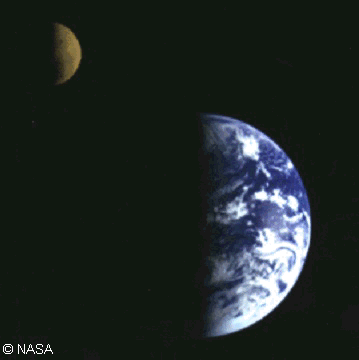More at 1 gigameter

This picture, taken by the Galileo spacecraft on its twisty flight to Jupiter, is one of the few times that the Earth and Moon have been photographed together. Galileo was nearly 4 million miles from Earth when this image was taken -- 16 times the distance from the Earth to the Moon. The Moon is in the foreground, moving from left to right. Antarctica is visible at the bottom of the Earth. Since the Moon lies between Galileo and the Earth, we are looking at the far side of the Moon -- the half we never see from Earth. Notice that the Moon is much dimmer than the Earth. The Moon reflects only 1/3 as much light as Earth.
Imagine being on the surface of the Moon and seeing the Earth in the Lunar sky:
- The Earth is four times the diameter of the Moon and covers 16 times more area. The Moon covers 1/2 degree in Earth's sky while the Earth covers two degrees of the Lunar sky. In addition, Earth reflects three times more light per unit area than the Moon, so Earth would be substantially brighter. Finally, Earth's rotation and constantly changing weather would make it an awesome sight!
- Earth would go through corresponding phases like the Moon, from new, to half, to full.
- The Earth would not rise or set, but would move up and down about 10 degrees along a north-south path twice each month, due to the 5 degree inclination of the Moon's orbital plane with respect to the Earth's equator. (If you stretch out your hand at arm's length, the distance between your thumb and middle finger is about 15 degrees.)
- Night and day would each last 14 Earth-days. The Sun would travel only 12 degrees in 24 hours. (The Sun moves 15 degrees per hour in Earth's sky.)
- If you lived on the back side of the Moon, you would never see the Earth. Could you infer the Earth's existence from the (apparent) motion of the Sun and stars every month -- or would it appear that you were living on a planet instead of a moon?
  Copyright © 2016 by Bruce Bryson Copyright © 2016 by Bruce Bryson |